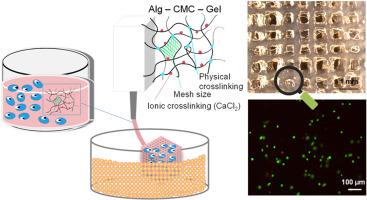Fabrication of 3D soft polymeric constructs at high structural integrity through bioprinting optimization of suspended hydrogels
Q1 Computer Science
引用次数: 0
Abstract
In vitro models of soft tissues, such as neural, vitreous, or hematopoietic human tissues, require three-dimensional (3D), soft, and functionalized constructs that mimic the complex extracellular microenvironment and support tissue growth and differentiation. While bioprinting has gained significant interest in bioengineering, there is limited research on process control for the biomanufacturing of soft tissues, which is still in its early stages. Material extrusion of suspended hydrogels has shown promise in processing low-viscosity inks, but challenges in developing bioinks that maintain good shape fidelity, repeatability, and long-term stability in culture media have slowly progressed. In this study, we optimize the bioprinting process for the suspended extrusion of low-viscosity autoclaved bioinks (η = 121 ± 4 mPa s from 50 to 100 s−1) into 3D soft polymeric constructs. The stability of the process is evaluated using a full factorial design approach. Bone marrow-derived stromal cells are bioprinted at a low concentration (5 × 105 cells/mL), showing excellent metabolic activity up to day 7 compared to 2D cell culture controls. The final soft constructs exhibit a compression Young's Modulus of 7.8 ± 0.9 kPa, a water uptake of 60 %, and minimal gel degradation over 21 days. This work offers new insights into optimizing this advanced bioprinting process towards the development and study of 3D in vitro soft tissue models.

通过生物打印优化悬浮水凝胶制备高结构完整性的三维软聚合物结构
软组织的体外模型,如神经、玻璃体或造血人体组织,需要三维(3D)、柔软和功能化的结构,以模拟复杂的细胞外微环境并支持组织生长和分化。虽然生物打印在生物工程领域引起了极大的兴趣,但对软组织生物制造过程控制的研究有限,仍处于早期阶段。悬浮水凝胶的材料挤压在处理低粘度油墨方面显示出前景,但在开发生物油墨方面的挑战,保持良好的形状保真度,可重复性和在培养基中的长期稳定性进展缓慢。在这项研究中,我们优化了生物打印工艺,将低粘度高压灭菌生物墨水(η = 121±4 mPa s,从50到100 s−1)悬浮挤出成三维软聚合物结构。采用全因子设计方法评价该工艺的稳定性。骨髓来源的基质细胞以低浓度(5 × 105个细胞/mL)进行生物打印,与2D细胞培养对照相比,在第7天显示出优异的代谢活性。最终的软结构的压缩杨氏模量为7.8±0.9 kPa,吸水率为60%,在21天内凝胶降解最小。这项工作为优化这种先进的生物打印工艺,开发和研究体外3D软组织模型提供了新的见解。
本文章由计算机程序翻译,如有差异,请以英文原文为准。
求助全文
约1分钟内获得全文
求助全文
来源期刊

Bioprinting
Computer Science-Computer Science Applications
CiteScore
11.50
自引率
0.00%
发文量
72
审稿时长
68 days
期刊介绍:
Bioprinting is a broad-spectrum, multidisciplinary journal that covers all aspects of 3D fabrication technology involving biological tissues, organs and cells for medical and biotechnology applications. Topics covered include nanomaterials, biomaterials, scaffolds, 3D printing technology, imaging and CAD/CAM software and hardware, post-printing bioreactor maturation, cell and biological factor patterning, biofabrication, tissue engineering and other applications of 3D bioprinting technology. Bioprinting publishes research reports describing novel results with high clinical significance in all areas of 3D bioprinting research. Bioprinting issues contain a wide variety of review and analysis articles covering topics relevant to 3D bioprinting ranging from basic biological, material and technical advances to pre-clinical and clinical applications of 3D bioprinting.
 求助内容:
求助内容: 应助结果提醒方式:
应助结果提醒方式:


